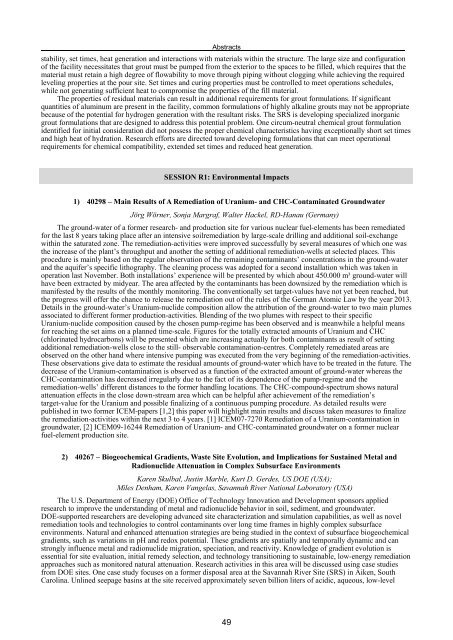The 13th International Conference on Environmental ... - Events
The 13th International Conference on Environmental ... - Events
The 13th International Conference on Environmental ... - Events
You also want an ePaper? Increase the reach of your titles
YUMPU automatically turns print PDFs into web optimized ePapers that Google loves.
Abstracts<br />
stability, set times, heat generati<strong>on</strong> and interacti<strong>on</strong>s with materials within the structure. <str<strong>on</strong>g>The</str<strong>on</strong>g> large size and c<strong>on</strong>figurati<strong>on</strong><br />
of the facility necessitates that grout must be pumped from the exterior to the spaces to be filled, which requires that the<br />
material must retain a high degree of flowability to move through piping without clogging while achieving the required<br />
leveling properties at the pour site. Set times and curing properties must be c<strong>on</strong>trolled to meet operati<strong>on</strong>s schedules,<br />
while not generating sufficient heat to compromise the properties of the fill material.<br />
<str<strong>on</strong>g>The</str<strong>on</strong>g> properties of residual materials can result in additi<strong>on</strong>al requirements for grout formulati<strong>on</strong>s. If significant<br />
quantities of aluminum are present in the facility, comm<strong>on</strong> formulati<strong>on</strong>s of highly alkaline grouts may not be appropriate<br />
because of the potential for hydrogen generati<strong>on</strong> with the resultant risks. <str<strong>on</strong>g>The</str<strong>on</strong>g> SRS is developing specialized inorganic<br />
grout formulati<strong>on</strong>s that are designed to address this potential problem. One circum-neutral chemical grout formulati<strong>on</strong><br />
identified for initial c<strong>on</strong>siderati<strong>on</strong> did not possess the proper chemical characteristics having excepti<strong>on</strong>ally short set times<br />
and high heat of hydrati<strong>on</strong>. Research efforts are directed toward developing formulati<strong>on</strong>s that can meet operati<strong>on</strong>al<br />
requirements for chemical compatibility, extended set times and reduced heat generati<strong>on</strong>.<br />
SESSION R1: Envir<strong>on</strong>mental Impacts<br />
1) 40298 – Main Results of A Remediati<strong>on</strong> of Uranium- and CHC-C<strong>on</strong>taminated Groundwater<br />
Jörg Wörner, S<strong>on</strong>ja Margraf, Walter Hackel, RD-Hanau (Germany)<br />
<str<strong>on</strong>g>The</str<strong>on</strong>g> ground-water of a former research- and producti<strong>on</strong> site for various nuclear fuel-elements has been remediated<br />
for the last 8 years taking place after an intensive soilremediati<strong>on</strong> by large-scale drilling and additi<strong>on</strong>al soil-exchange<br />
within the saturated z<strong>on</strong>e. <str<strong>on</strong>g>The</str<strong>on</strong>g> remediati<strong>on</strong>-activities were improved successfully by several measures of which <strong>on</strong>e was<br />
the increase of the plant’s throughput and another the setting of additi<strong>on</strong>al remediati<strong>on</strong>-wells at selected places. This<br />
procedure is mainly based <strong>on</strong> the regular observati<strong>on</strong> of the remaining c<strong>on</strong>taminants’ c<strong>on</strong>centrati<strong>on</strong>s in the ground-water<br />
and the aquifer’s specific lithography. <str<strong>on</strong>g>The</str<strong>on</strong>g> cleaning process was adopted for a sec<strong>on</strong>d installati<strong>on</strong> which was taken in<br />
operati<strong>on</strong> last November. Both installati<strong>on</strong>s’ experience will be presented by which about 450.000 m³ ground-water will<br />
have been extracted by midyear. <str<strong>on</strong>g>The</str<strong>on</strong>g> area affected by the c<strong>on</strong>taminants has been downsized by the remediati<strong>on</strong> which is<br />
manifested by the results of the m<strong>on</strong>thly m<strong>on</strong>itoring. <str<strong>on</strong>g>The</str<strong>on</strong>g> c<strong>on</strong>venti<strong>on</strong>ally set target-values have not yet been reached, but<br />
the progress will offer the chance to release the remediati<strong>on</strong> out of the rules of the German Atomic Law by the year 2013.<br />
Details in the ground-water’s Uranium-nuclide compositi<strong>on</strong> allow the attributi<strong>on</strong> of the ground-water to two main plumes<br />
associated to different former producti<strong>on</strong>-activities. Blending of the two plumes with respect to their specific<br />
Uranium-nuclide compositi<strong>on</strong> caused by the chosen pump-regime has been observed and is meanwhile a helpful means<br />
for reaching the set aims <strong>on</strong> a planned time-scale. Figures for the totally extracted amounts of Uranium and CHC<br />
(chlorinated hydrocarb<strong>on</strong>s) will be presented which are increasing actually for both c<strong>on</strong>taminants as result of setting<br />
additi<strong>on</strong>al remediati<strong>on</strong>-wells close to the still- observable c<strong>on</strong>taminati<strong>on</strong>-centres. Completely remediated areas are<br />
observed <strong>on</strong> the other hand where intensive pumping was executed from the very beginning of the remediati<strong>on</strong>-activities.<br />
<str<strong>on</strong>g>The</str<strong>on</strong>g>se observati<strong>on</strong>s give data to estimate the residual amounts of ground-water which have to be treated in the future. <str<strong>on</strong>g>The</str<strong>on</strong>g><br />
decrease of the Uranium-c<strong>on</strong>taminati<strong>on</strong> is observed as a functi<strong>on</strong> of the extracted amount of ground-water whereas the<br />
CHC-c<strong>on</strong>taminati<strong>on</strong> has decreased irregularly due to the fact of its dependence of the pump-regime and the<br />
remediati<strong>on</strong>-wells’ different distances to the former handling locati<strong>on</strong>s. <str<strong>on</strong>g>The</str<strong>on</strong>g> CHC-compound-spectrum shows natural<br />
attenuati<strong>on</strong> effects in the close down-stream area which can be helpful after achievement of the remediati<strong>on</strong>’s<br />
target-value for the Uranium and possible finalizing of a c<strong>on</strong>tinuous pumping procedure. As detailed results were<br />
published in two former ICEM-papers [1,2] this paper will highlight main results and discuss taken measures to finalize<br />
the remediati<strong>on</strong>-activities within the next 3 to 4 years. [1] ICEM07-7270 Remediati<strong>on</strong> of a Uranium-c<strong>on</strong>taminati<strong>on</strong> in<br />
groundwater, [2] ICEM09-16244 Remediati<strong>on</strong> of Uranium- and CHC-c<strong>on</strong>taminated groundwater <strong>on</strong> a former nuclear<br />
fuel-element producti<strong>on</strong> site.<br />
2) 40267 – Biogeochemical Gradients, Waste Site Evoluti<strong>on</strong>, and Implicati<strong>on</strong>s for Sustained Metal and<br />
Radi<strong>on</strong>uclide Attenuati<strong>on</strong> in Complex Subsurface Envir<strong>on</strong>ments<br />
Karen Skulbal, Justin Marble, Kurt D. Gerdes, US DOE (USA);<br />
Miles Denham, Karen Vangelas, Savannah River Nati<strong>on</strong>al Laboratory (USA)<br />
<str<strong>on</strong>g>The</str<strong>on</strong>g> U.S. Department of Energy (DOE) Office of Technology Innovati<strong>on</strong> and Development sp<strong>on</strong>sors applied<br />
research to improve the understanding of metal and radi<strong>on</strong>uclide behavior in soil, sediment, and groundwater.<br />
DOE-supported researchers are developing advanced site characterizati<strong>on</strong> and simulati<strong>on</strong> capabilities, as well as novel<br />
remediati<strong>on</strong> tools and technologies to c<strong>on</strong>trol c<strong>on</strong>taminants over l<strong>on</strong>g time frames in highly complex subsurface<br />
envir<strong>on</strong>ments. Natural and enhanced attenuati<strong>on</strong> strategies are being studied in the c<strong>on</strong>text of subsurface biogeochemical<br />
gradients, such as variati<strong>on</strong>s in pH and redox potential. <str<strong>on</strong>g>The</str<strong>on</strong>g>se gradients are spatially and temporally dynamic and can<br />
str<strong>on</strong>gly influence metal and radi<strong>on</strong>uclide migrati<strong>on</strong>, speciati<strong>on</strong>, and reactivity. Knowledge of gradient evoluti<strong>on</strong> is<br />
essential for site evaluati<strong>on</strong>, initial remedy selecti<strong>on</strong>, and technology transiti<strong>on</strong>ing to sustainable, low-energy remediati<strong>on</strong><br />
approaches such as m<strong>on</strong>itored natural attenuati<strong>on</strong>. Research activities in this area will be discussed using case studies<br />
from DOE sites. One case study focuses <strong>on</strong> a former disposal area at the Savannah River Site (SRS) in Aiken, South<br />
Carolina. Unlined seepage basins at the site received approximately seven billi<strong>on</strong> liters of acidic, aqueous, low-level<br />
49
















